Climate Change Impacts on Frost and Thaw Considerations: Case Study of Airport Pavement Design in Canada
Abstract
:1. Introduction
2. Background
2.1. Frost Penetration and Heave
2.2. Permafrost Thawing
3. Methodology
4. Results
4.1. Analysis I: Comparison of Different Methods
4.2. Climate Change Scenarios (Analysis II)
4.2.1. TCCA and MTO Methods
4.2.2. MTQ Method
5. Discussion
6. Conclusions
Author Contributions
Funding
Institutional Review Board Statement
Informed Consent Statement
Data Availability Statement
Conflicts of Interest
References
- Environment and Climate Change Canada. Canada’s Changing Climate Report; Environment and Climate Change Canada: Gatineau, QC, Canada, 2019. [Google Scholar]
- Daniel, J.S.; Jacobs, J.M.; Miller, H.; Stoner, A.; Crowley, J.; Khalkhali, M.; Thomas, A. Climate change: Potential impacts on frost–thaw conditions and seasonal load restriction timing for low-volume roadways. Road Mater. Pavement Des. 2018, 19, 1126–1146. [Google Scholar] [CrossRef]
- TCCA. Manual of Pavement Structural Design ASG-19; Transport Canada Civil Aviation: Ottawa, ON, Canada, 1992. [Google Scholar]
- Argue, G.H.; Denyes, B.B. Estimating the depth of pavement frost and thaw penetrations. Transp. Res. Rec. 1974, 2, 21–25. [Google Scholar]
- TCCA. Pavement Structural Design Training Manual, ATR-021, AK-77-68-300; Public Works & Government Services Canada: Victoria, BC, Canada, 1995. [Google Scholar]
- Chamberlain, E.J. Frost Susceptibility of Soil, Review of Index Tests; Cold Regions Research and Engineering Lab: Hanover, NH, USA, 1981. [Google Scholar]
- St-Laurent, D. Routine mechanistic pavement design against frost heave. In Cold Regions Engineering 2012: Sustainable Infrastructure Development in a Changing Cold Environment; ASCE: Reston, VA, USA, 2012. [Google Scholar]
- Saarelainen, S. Modelling Frost Heaving and Frost Penetration in Soils at Some Observation Sites in Finland: The SSR Model. Ph.D. Thesis, Tampere University of Technology, Tampere, Finland, 1992. [Google Scholar]
- Doré, G.; Grellet, D.; Richard, C.; Bilodeau, J.P.; Pérez-González, E.L.; Barón, H.M.F. Mechanistic-Empirical Flexible Pavement Design Software: i3c-me User’s Manual; Department of Civil and Water Engineering Université Laval: Québec City, QC, Canada, 2019. [Google Scholar]
- Andersland, O.B.; Ladanyi, B. Frozen Ground Engineering; John Wiley & Sons: Hoboken, NJ, USA, 2003. [Google Scholar]
- Smith, S.L.; Burgess, M.M. Sensitivity of Permafrost to Climate Warming in Canada. 2004. Available online: https://www.osti.gov/etdeweb/biblio/20581743 (accessed on 15 November 2021).
- Abreu, E.A. Impacts of Climate Change on Canadian Airport Pavements. Master’s Thesis, University of Waterloo, Waterloo, ON, Canada, 2019. [Google Scholar]
- Özgan, E.; Serin, S. Investigation of certain engineering characteristics of asphalt concrete exposed to freeze–thaw cycles. Cold Reg. Sci. Technol. 2013, 85, 131–136. [Google Scholar] [CrossRef]
- Feng, D.; Yi, J.; Wang, D.; Chen, L. Impact of salt and freeze–thaw cycles on performance of asphalt mixtures in coastal frozen region of China. Cold Reg. Sci. Technol. 2010, 62, 34–41. [Google Scholar] [CrossRef]
- Boutonnet, M.; Savard, Y.; Lerat, P.; St-Laurent, D.; Pouliot, N. Thermal aspect of frost-thaw pavement di-mensioning: In situ measurement and numerical modeling. Transp. Res. Rec. 2003, 1821, 3–12. [Google Scholar] [CrossRef]
- Government of Canada. Historical Climate Data. 25 November 2021. Available online: https://climate.weather.gc.ca/ (accessed on 4 February 2022).
- National Solar Radiation Database (NSRDB). NSRDB Data Viewer. Available online: https://nsrdb.nrel.gov/ (accessed on 16 February 2022).
- Prairie Climate Centre. Climate Atlas of Canada. Available online: https://climateatlas.ca/ (accessed on 4 November 2021).
- Ministry of Transportation of Ontario. Pavement Design and Rehabilitation Manual; Materials Engineering and Research Office: Toronto, ON, Canada, 2013. [Google Scholar]

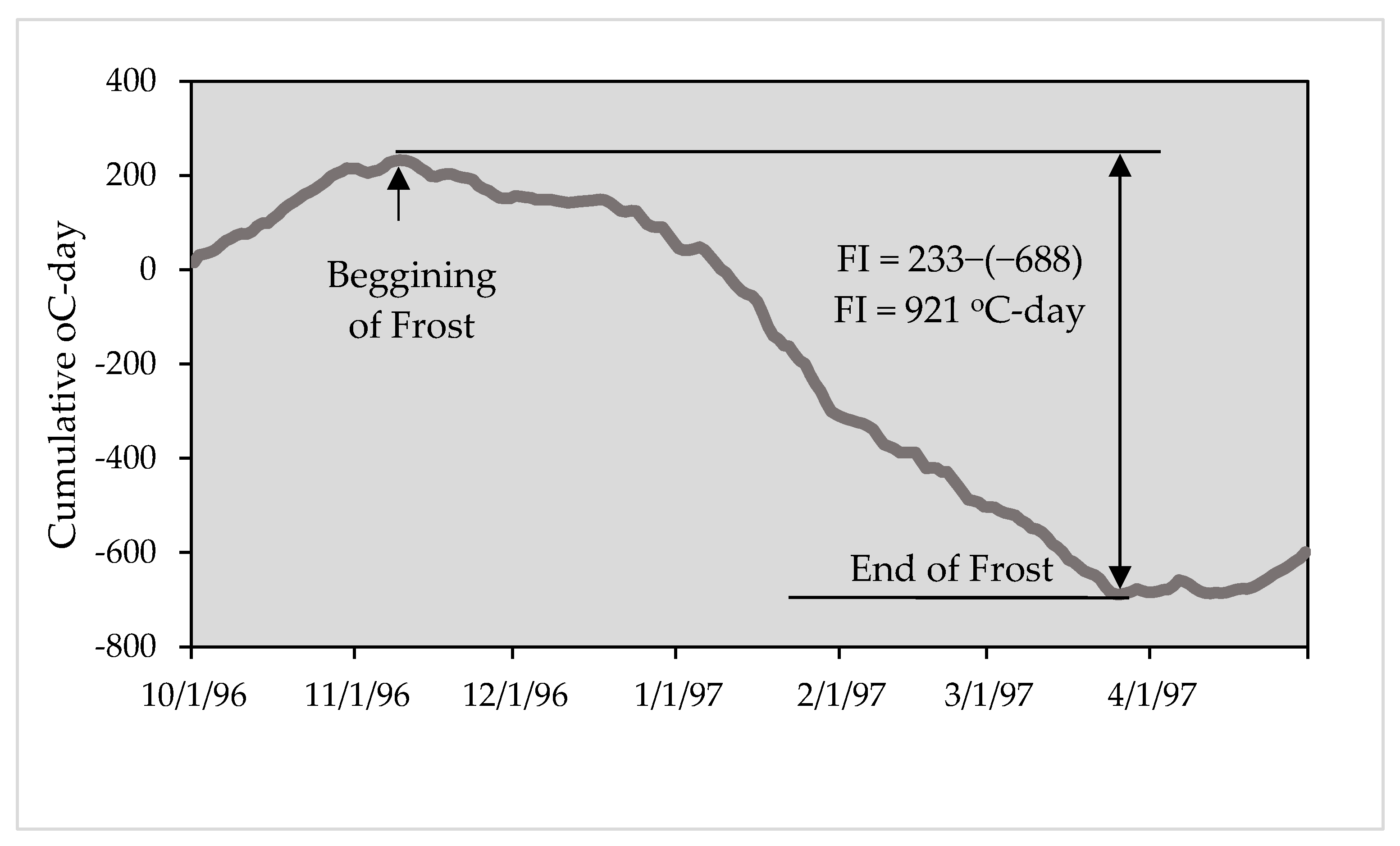
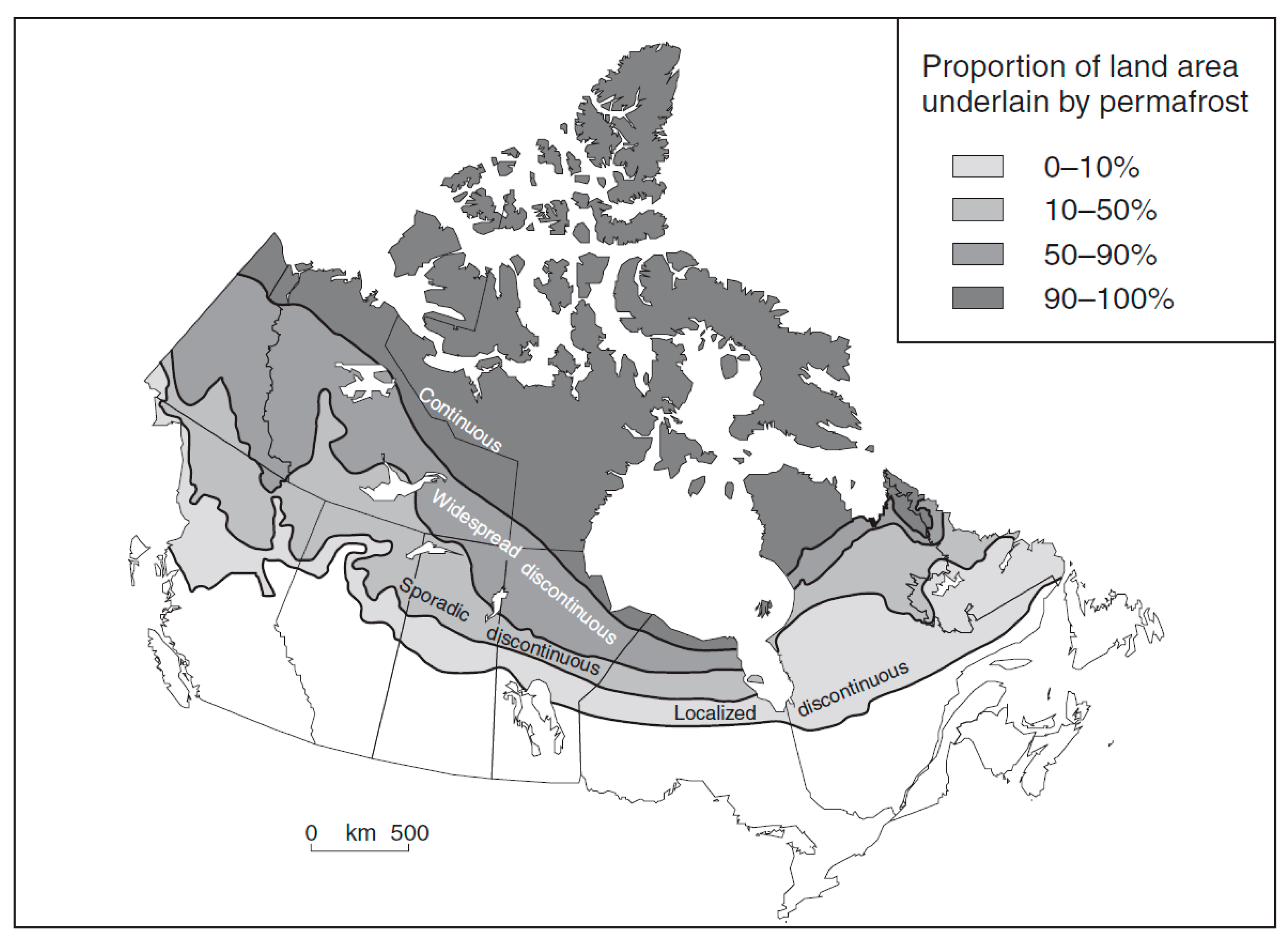
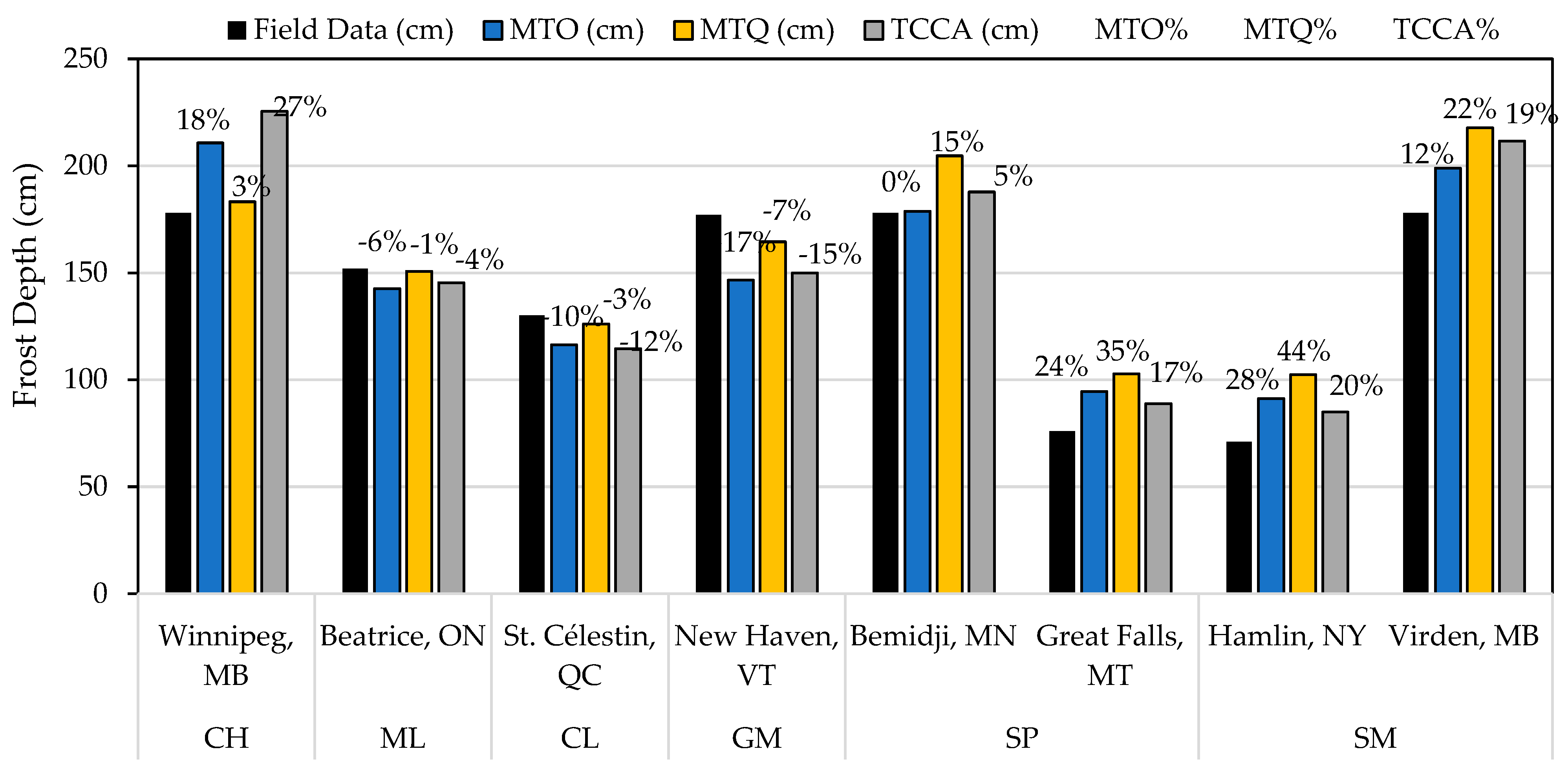
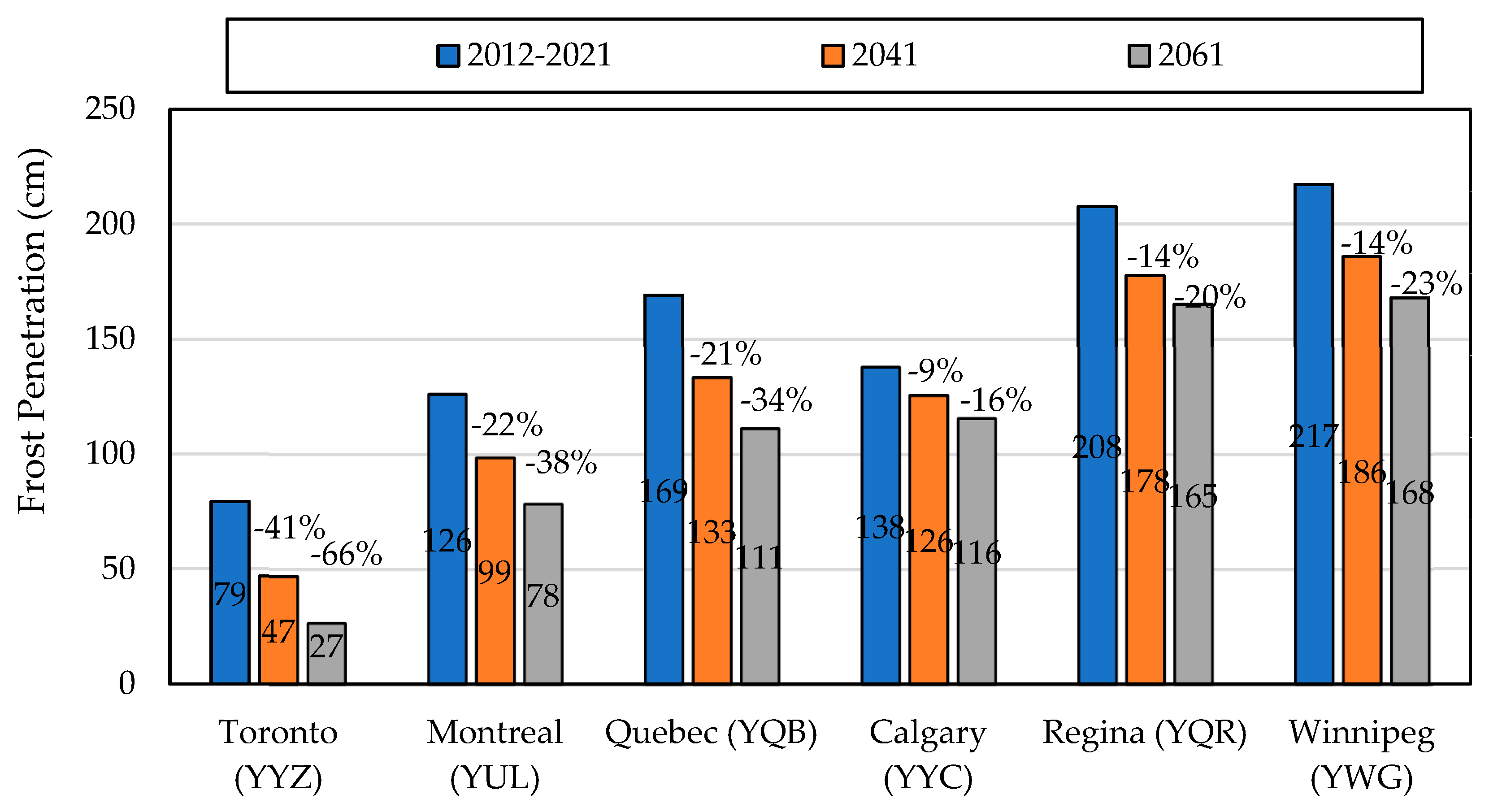
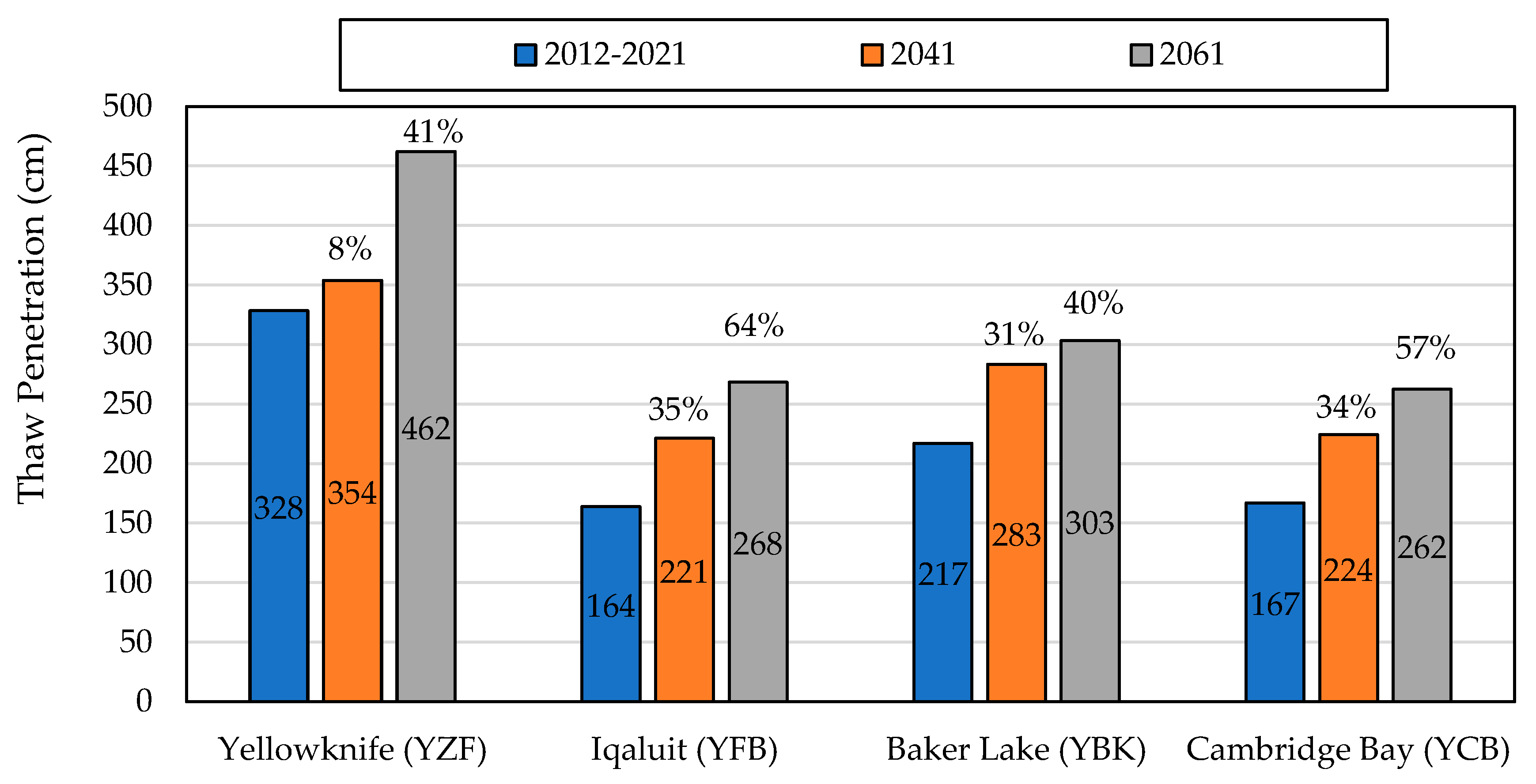
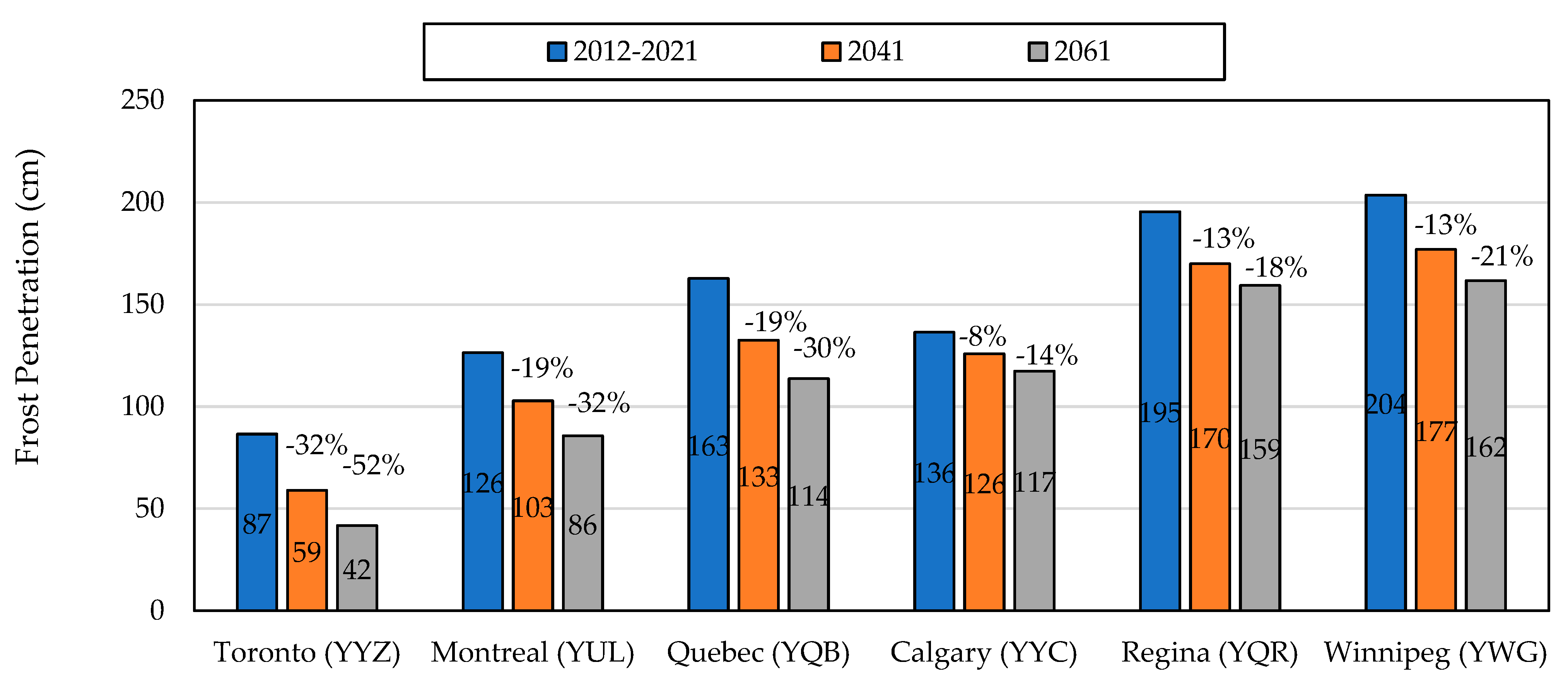
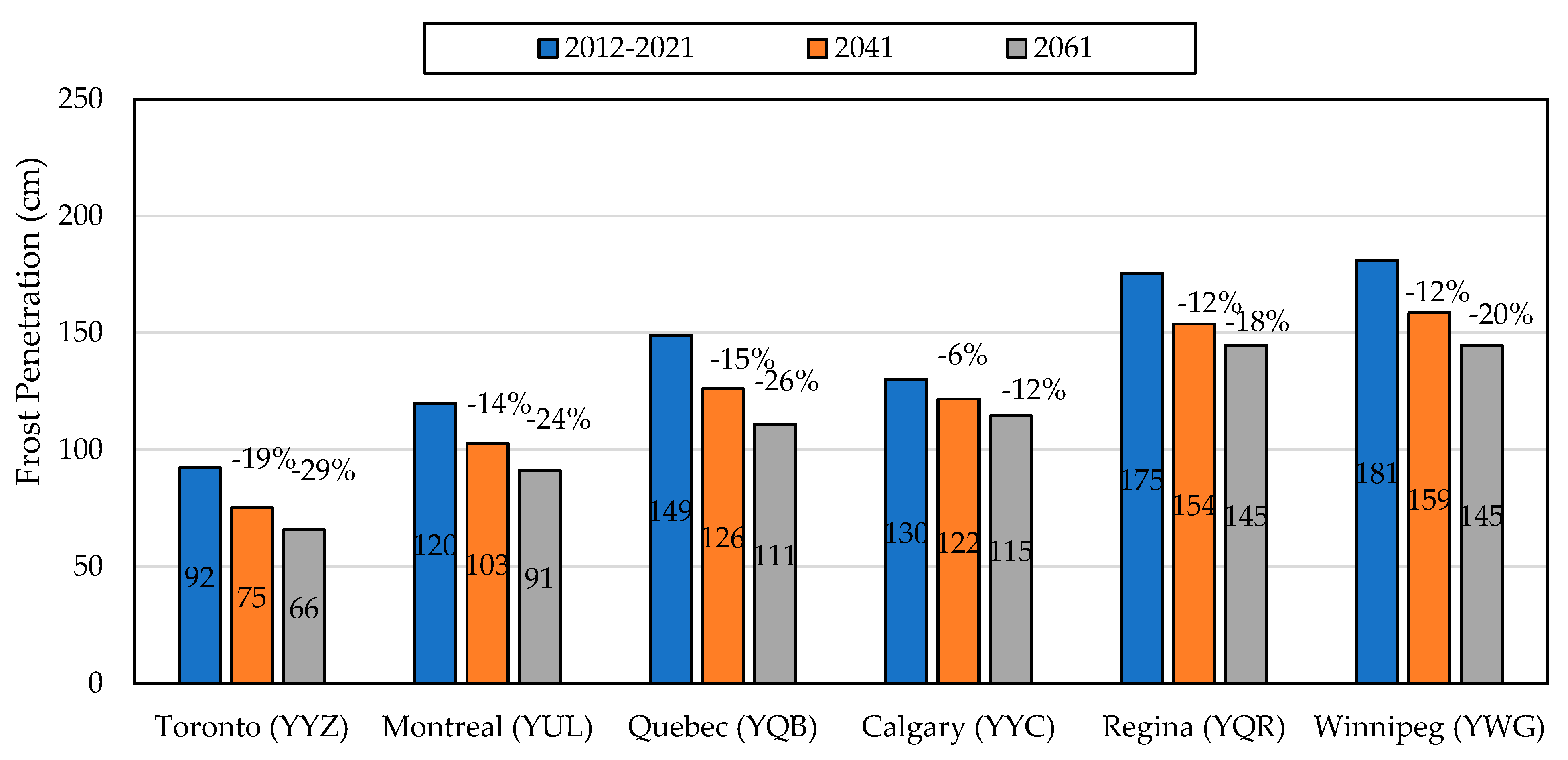
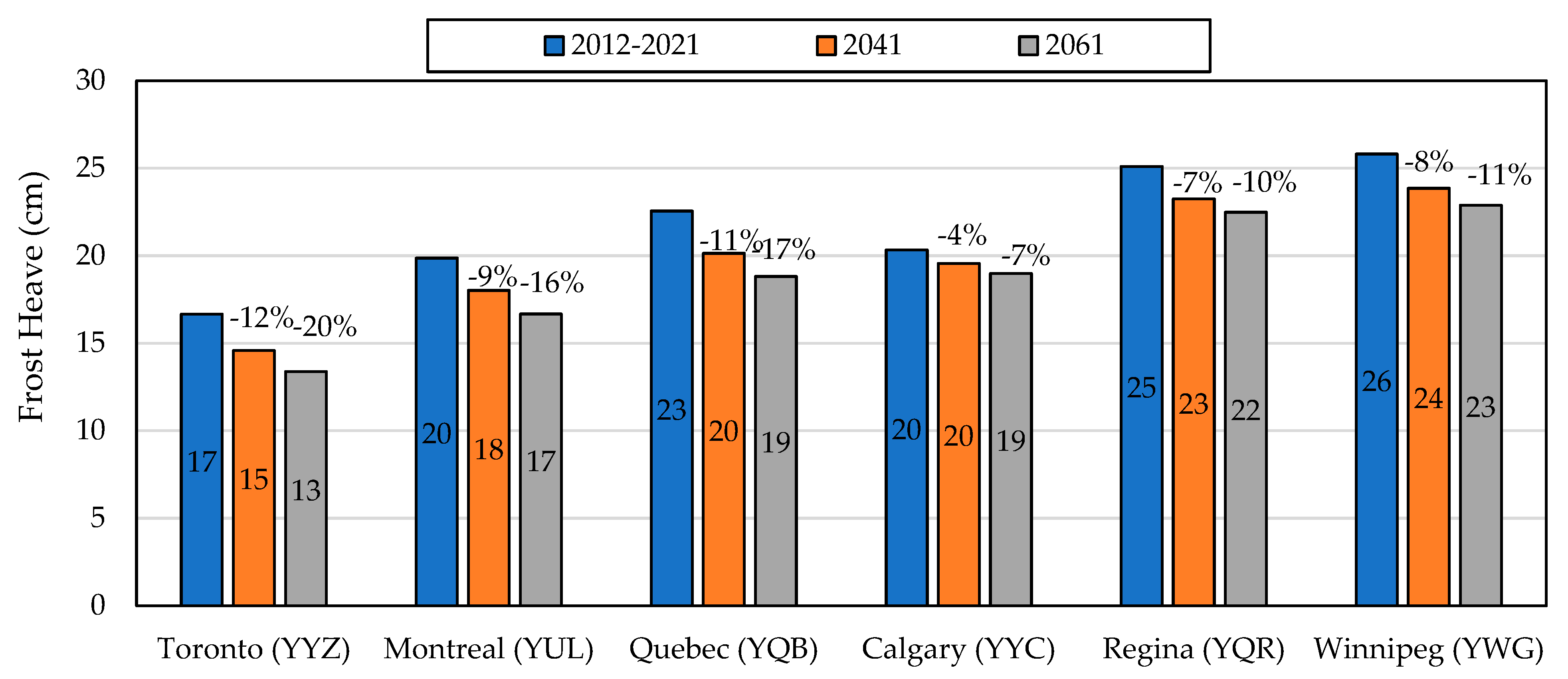
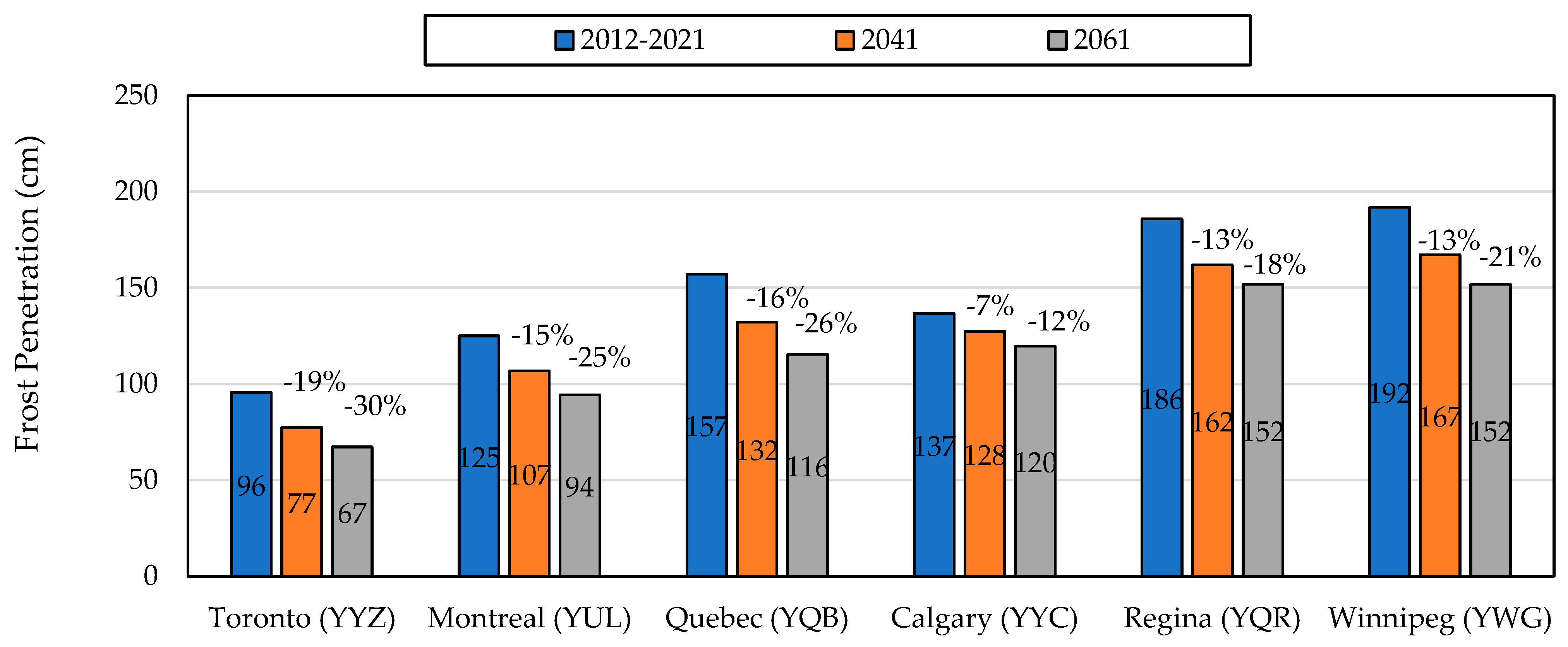
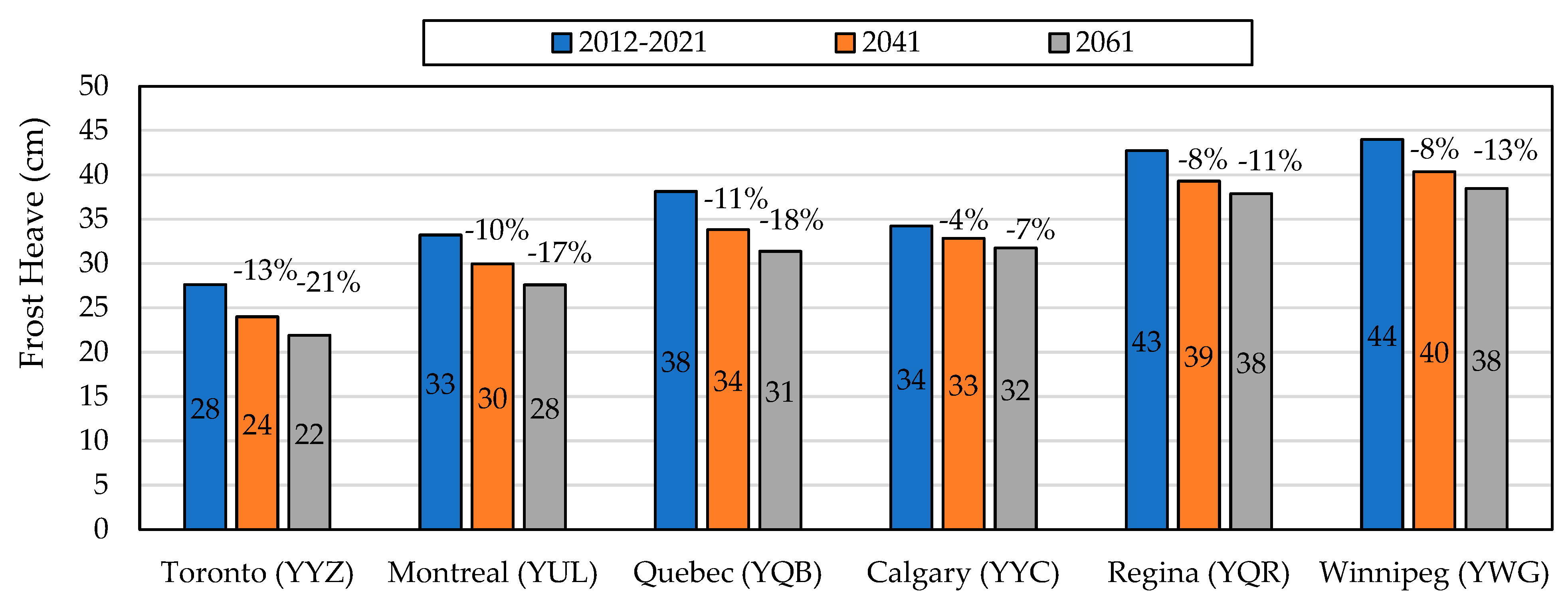
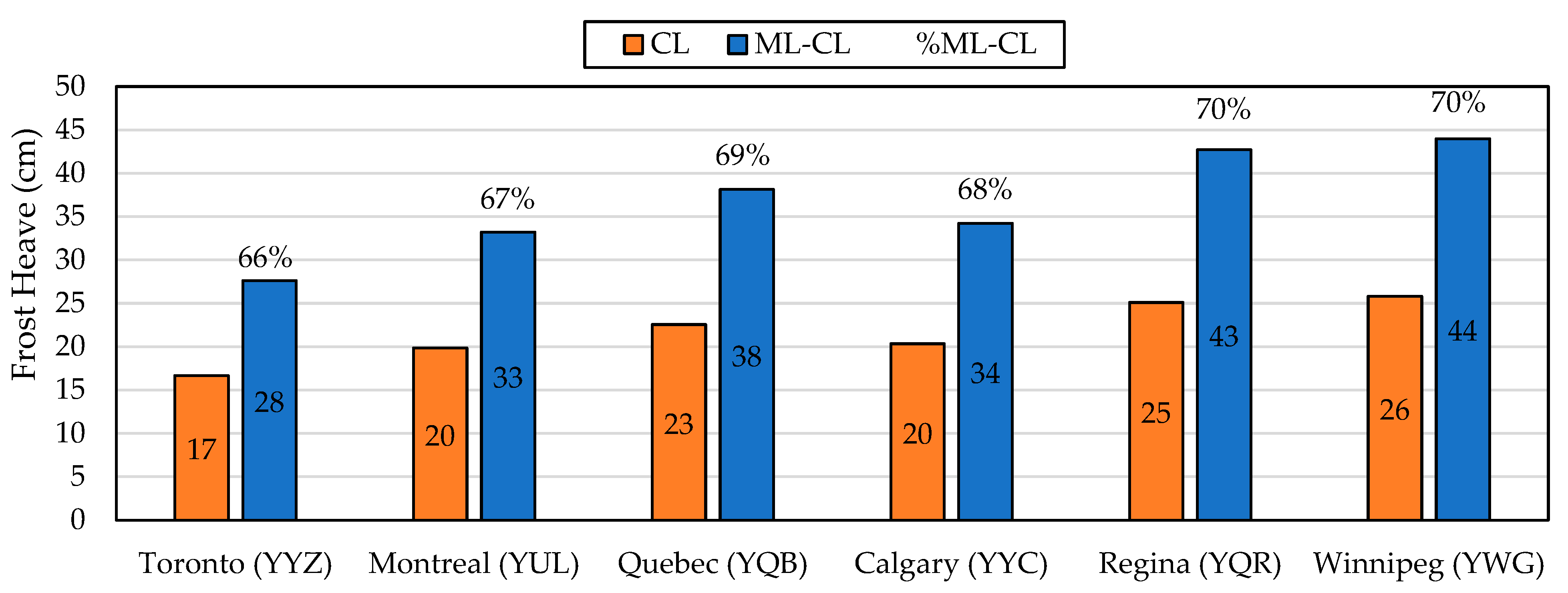
| Analysis I | Analysis II |
|---|---|
Canada:
| Not underlain by permafrost
|
U.S.A.
| Underlain by Permafrost
|
| ID | Year | Soil Description | Closest City | Frost Depth (cm) | AMT (°C) | FI °C-Days |
|---|---|---|---|---|---|---|
| 83_3802 | 93/94 | Fat Inorganic Clay | Winnipeg, MB | 178 | 2.60 | 1775 |
| 87_1622 | 96/97 | Sandy Silt | Beatrice, ON | 152 | 4.78 | 921 |
| - | 98/99 | Silty Clay | St. Célestin, QC | 130 | 5.10 | 666 |
| 50_1002 | 02/03 | Poorly Graded Gravel with Silt & Sand | New Haven, VT | 177 | 11.00 | 963 |
| 27_6251 | 02/03 | Poorly Graded Sand with Silt | Bemidji, MN | 178 | 4.58 | 1339 |
| 30_0114 | 03/04 | Poorly Graded Sand with Silt | Great Falls, MT | 76 | 8.25 | 486 |
| 36_0801 | 03/04 | Silty Sand | Hamlin, NY | 71 | 4.25 | 1170 |
| 83_1801 | 02/03 | Silty Sand | Virden, MB | 178 | 9.08 | 461 |
| 90_6405 | 95/96 | Fat Inorganic Clay | Viscount, SK | 177 | 2.75 | 1607 |
| Closest City | Pavement Structure: Material (Thickness in cm) | Soil Type | Soil Class |
|---|---|---|---|
| Winnipeg, MB | AC (15.24) Concrete (24.89) Granular (12.446) Granular (14.986) | Fat Inorganic Clay (CH) | CH |
| Beatrice, ON | AC (14.48) AC (11.68) Granular (17.02) Granular (66.80) | Sandy Silt (ML) | ML |
| St. Célestin, QC | AC (18) Granular (30) Granular (42) | Silty Clay (CL) | CL |
| New Haven, VT | AC (7.62) AC (13.97) Granular (65.53) | Poorly Graded Gravel with Silt and Sand (GM) | GM |
| Bemidji, MN | AC (8.64) AC (14.73) Granular (25.91) | Poorly Graded Sand with Silt (SP) | SP |
| Great Falls, MT | AC (19.05) Granular (31.50) | Poorly Graded Sand with Silt (SP) | |
| Hamlin, NY | AC (3.05) AC (9.65) Granular (21.34) | Silty Sand (SM) | SM |
| Virden, MB | AC (11.18) Granular (14.22) granular (33.53) | Silty Sand (SM) | |
| Viscount, SK | AC (15.49) Granular (22.86) Sand Asphalt (6.35) | Silty Sand (SM) |
| Soil Type | Coarse | Fine | ||||
|---|---|---|---|---|---|---|
| Method | MTO | MTQ | TCCA | MTO | MTQ | TCCA |
| Min. | 0% | 7% | 5% | 6% | 1% | 4% |
| Max. | 28% | 44% | 20% | 18% | 3% | 27% |
| Standard Deviation | 10% | 13% | 5% | 6% | 1% | 11% |
| Average Difference | 20% | 28% | 21% | 12% | 2% | 14% |
| Airport | AMT Ψ | AMT 2041 | AMT 2061 | FI/*TI | FI/*TI 2041 | FI/*TI 2061 | Temp. Change 2041 | Temp. Change 2061 |
|---|---|---|---|---|---|---|---|---|
| Toronto (YYZ) | 9 | 11 | 12 | 426 | 252 | 166 | 2 | 3 |
| Montreal (YUL) | 8 | 9 | 10 | 758 | 551 | 420 | 1 | 2 |
| Quebec (YQB) | 5 | 6 | 8 | 1144 | 818 | 642 | 1 | 3 |
| Calgary (YYC) | 5 | 6 | 7 | 857 | 754 | 675 | 1 | 2 |
| Regina (YQR) | 3 | 5 | 6 | 1560 | 1231 | 1105 | 2 | 3 |
| Winnipeg (YWG) | 3 | 5 | 7 | 1674 | 1317 | 1133 | 2 | 4 |
| Yellowknife (YZF) | −4 | −1 | 0 | 1860 * | 2099 * | 3273 * | 3 | 4 |
| Iqaluit (YFB) | −8 | −6 | −4 | 666 * | 1015 * | 1355 * | 2 | 4 |
| Baker Lake (YBK) | −10 | −7 | −6 | 986 * | 1474 * | 1639 * | 3 | 4 |
| Cambridge Bay (YCB) | −13 | −10 | −8 | 683 * | 1035 * | 1310 * | 3 | 5 |
| Soil | Geotechnical Parameters | Thermal Conductivity Parameters | |||||||||
|---|---|---|---|---|---|---|---|---|---|---|---|
| (kg/m3) | (kg/m3) | (%) | (m2/g) | (°C) | χ (°C) | η | a (MPa−1) | SP0 (mm2/°K.H) | |||
| CL | 2750 | 1300 | 34 | 60 | 2.9 | 1.7 | 1.8 | 1.9 | 0.9 | 7.0 | 5.0 |
| ML | 2700 | 1450 | 30 | 40 | 2.9 | 1.7 | 1.8 | 1.9 | 0.9 | 7.0 | 8.0 |
Disclaimer/Publisher’s Note: The statements, opinions and data contained in all publications are solely those of the individual author(s) and contributor(s) and not of MDPI and/or the editor(s). MDPI and/or the editor(s) disclaim responsibility for any injury to people or property resulting from any ideas, methods, instructions or products referred to in the content. |
© 2023 by the authors. Licensee MDPI, Basel, Switzerland. This article is an open access article distributed under the terms and conditions of the Creative Commons Attribution (CC BY) license (https://creativecommons.org/licenses/by/4.0/).
Share and Cite
Sutherland Rolim Barbi, P.; Tavassoti, P.; Tighe, S.L. Climate Change Impacts on Frost and Thaw Considerations: Case Study of Airport Pavement Design in Canada. Appl. Sci. 2023, 13, 7801. https://doi.org/10.3390/app13137801
Sutherland Rolim Barbi P, Tavassoti P, Tighe SL. Climate Change Impacts on Frost and Thaw Considerations: Case Study of Airport Pavement Design in Canada. Applied Sciences. 2023; 13(13):7801. https://doi.org/10.3390/app13137801
Chicago/Turabian StyleSutherland Rolim Barbi, Paula, Pejoohan Tavassoti, and Susan L. Tighe. 2023. "Climate Change Impacts on Frost and Thaw Considerations: Case Study of Airport Pavement Design in Canada" Applied Sciences 13, no. 13: 7801. https://doi.org/10.3390/app13137801
APA StyleSutherland Rolim Barbi, P., Tavassoti, P., & Tighe, S. L. (2023). Climate Change Impacts on Frost and Thaw Considerations: Case Study of Airport Pavement Design in Canada. Applied Sciences, 13(13), 7801. https://doi.org/10.3390/app13137801






